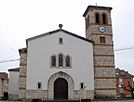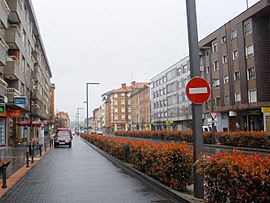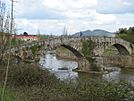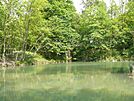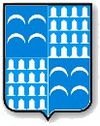Lugones, Siero facts for kids
Quick facts for kids
Lugones
Llugones (Asturian)
|
|||
|---|---|---|---|
|
Parish
|
|||
| Lugones/Llugones | |||
|
From top: Church of San Felix, the 'Old Schools' building, Oviedo Avenue, the 'Old' (Vieyu) Bridge, L'Acebera park,
|
|||
|
|||
| Country | Spain | ||
| Autonomous community | Asturias | ||
| Province | Asturias | ||
| Municipality | Siero | ||
| Area | |||
| • Total | 5.48 km2 (2.12 sq mi) | ||
| Elevation | 170 m (560 ft) | ||
| Population
(2019)
|
|||
| • Total | 13,191 | ||
| • Density | 2,407.1/km2 (6,234/sq mi) | ||
| Demonym(s) | lugonino, -a or lugonense (es) llugoninu, -a, -o or llugonense (ast) |
||
| Postal code |
33420
|
||
Lugones (called Llugones in Asturian language) is a small area in Siero. Siero is a town in the region of Asturias, northern Spain. Lugones is known as a parish, which is a type of local division in Spain.
It covers about 5.48 square kilometers (2.12 square miles). In 2006, about 11,646 people lived there. Lugones is located 159 meters (522 feet) above sea level. Its postal code is 33420.
Lugones has been around since before the Roman Empire. It was named after the Luggoni tribe. This tribe was named after Lug, a Celtic god.
Contents
History of Lugones
Ancient Times
The name Lugones comes from an old Celtic tribe called the Luggoni. This tribe was very important in the middle of what is now Asturias. The word Luggoni comes from the Celtic word lug, which means "bright."
Lug was also a sun god, a main god for the Celts in Spain. The Luggoni believed they were descendants of Lug. This meant they were the "children of light." Ancient writings show that the Luggoni tribe lived in the area where Lugones is now. They were part of the Astures people, who had strong Celtic roots. In 572 AD, King Miro of the Suebi people attacked the Luggoni.
Near Lugones, there are old sites like "Castro La Torre." A castro is an ancient fortified village. This one was on a hill by the Nora River. In 1957, an archaeologist found a Roman villa (a large Roman house) nearby. They found pieces of pottery there. The names of places like Murias and Paredes, where these things were found, are important clues.
In 1997, workers building a shopping center found a necropolis (an ancient cemetery). It was likely connected to the Roman villa. Today, you can visit the remains of the necropolis. Most of the items found are in the Archaeological Museum of Asturias.
An old bridge, called Puente Vieyu (Old Bridge), also dates back to Roman times. It was later rebuilt. This bridge connected Oviedo to Lugones. It was part of a Roman road that linked "Astúrica Augusta" (Astorga) and "Lucus Asturum" (Lugo de Llanera).
Modern Development
In 1882, a gunpowder factory opened in Lugones. It was started by José Tartiere. Lugones was chosen because it had great connections. Roads from Oviedo led to Avilés and Gijón through Lugones.
Later, railway lines opened in 1884 and 1891. These lines helped Lugones grow industrially. In 1896, a metal factory also opened.
Because of all these developments, King Alfonso XIII gave José Tartiere a special title in 1922. He became the Count of Saint Barbara of Lugones.
In the early 1900s, more factories and businesses came to Lugones. This caused its population to triple. Lugones became a "dormitory town" for Oviedo. This means many people lived in Lugones but worked in Oviedo.
Geography
Location and Borders
Lugones is located in the middle of Asturias. The parish covers 5.48 square kilometers (2.12 square miles). To the south, it borders the city of Oviedo. The Nora River forms a natural border between Lugones and Oviedo's La Corredoria neighborhood.
To the north, Lugones borders Llanera and Viella, another parish in Siero. To the east, it borders Viella and Granda, also Siero parishes. To the west, it borders Villaperi and Naranco, both parishes in Oviedo.
Local Villages
Lugones includes several smaller villages and hamlets. These are El Carbayu, El Castro, El Cuetu, La Ería, Folgueras, Los Molinos, Paredes, Los Peñones, Puente Vieyu, El Resbalón, San José, El Sucu, La Torre, and El Villar.
Population Changes
| Historical population | ||
|---|---|---|
| Year | Pop. | ±% |
| 2001 | 11,543 | — |
| 2002 | 11,570 | +0.2% |
| 2003 | 11,588 | +0.2% |
| 2004 | 11,528 | −0.5% |
| 2005 | 11,495 | −0.3% |
| 2006 | 11,646 | +1.3% |
| 2007 | 11,765 | +1.0% |
| 2008 | 12,224 | +3.9% |
| 2009 | 12,602 | +3.1% |
| 2010 | 12,727 | +1.0% |
| 2011 | 12,860 | +1.0% |
| 2012 | 12,967 | +0.8% |
| 2013 | 13,054 | +0.7% |
| 2014 | 13,107 | +0.4% |
| 2015 | 13,109 | +0.0% |
| 2016 | 13,109 | +0.0% |
| 2017 | 13,052 | −0.4% |
| 2018 | 13,088 | +0.3% |
| 2019 | 13,191 | +0.8% |
| 2020 | 13,139 | −0.4% |
| 2021 | 13,135 | −0.0% |
| Source: Instituto Nacional de Estadística | ||
Lugones' population has grown a lot since the early 1900s. In 2021, 13,135 people lived in the parish. Most of them (over 99%) lived in the main town of Lugones.
A small number of people live in the rural areas. For example, 79 people lived in Paredes, and only 7 in Les Folgueres.
In 2018, about 611 people living in Lugones were from other countries. This was 40% of all foreign people in Siero. Foreign residents make up about 4% of Lugones' population. People from China, Colombia, Morocco, Portugal, Romania, Brazil, Paraguay, Venezuela, and Ukraine live there.
Places to See
Parks and Green Spaces
Lugones has some nice parks and green areas:
- Parque de la Paz: This park is also known as Parque de la Manzana Central. It's in the center of Lugones. It has a bandstand, a play area for kids, and a small cycling track.
- L'Acebera Park: This park is on the edge of town. It used to belong to the Santa Barbara Society until 1982. This company, owned by the Count of Saint Bárbara, used the area to test explosives. They also stored explosives and other factory buildings there. You can still see some remains of these buildings today. The city bought the park in 1982. It became a proper park in 2001. Now, it has a lake, a waterfall, picnic spots, and a playground.
Culture and Fun
Cultural Centers
The main cultural center in Lugones is the Centro Polivalente Integrado (Integrated Multipurpose Center), or CPI. It opened in 2020. It replaced the older Casa de la Cultura (House of Culture). The CPI has a large auditorium for 540 people. It also has a conference room for 107 people. There is a library and several local government offices inside.
Festivals and Celebrations
Lugones has two main patron saint festivals:
- Nuestra Señora del Buen Suceso: Also known as El Carbayu, this festival is held on the first weekend of August.
- Santa Isabel: Celebrated in the last week of August. During this time, "La Ruta de Lugones" takes place. Many young people join this "route" through the town's bars and pubs.
People also celebrate Saint John's bonfires.
In April, the La Sidrina Folkloric Association gives out the "Pueblo de Lugones" Award. They also have an exhibition about Asturian Culture. On the last Saturday of August, they organize the International Folkloric Exhibition of Lugones. The Lugones Se Mueve Cultural Association hosts a Popular Cider Test in April and a Beer Festival in June.
Sports
Sports Facilities
Lugones has several sports facilities:
- An artificial turf soccer field. This is where the local teams, Atlético de Lugones SD and Beredi CF, play their matches.
- An Asturian-style bowling alley. This alley has hosted big competitions, even international ones.
- Outdoor swimming pools at L'Acebera park.
- A municipal sports complex. This complex has a sports court, a gym, a sauna, and a heated pool.
Economy
Lugones is surrounded by industrial areas. It's also about 5 kilometers (3 miles) from Oviedo. Its central location in Asturias helps it attract many visitors. People come for fun and to shop.
Lugones has many places to eat and drink. These include cider houses and restaurants. Many of them are on a street called "La Peatonal." This street is a symbol of the local food scene. It brings in tourists and money for Lugones and Siero.
Lugones grew quickly from the 1970s. It became a "dormitory town," meaning people lived there and traveled to work elsewhere. Two of Asturias' busiest shopping centers, Parque Principado and Azabache, are near Lugones.
See also
 In Spanish: Lugones (Siero) para niños
In Spanish: Lugones (Siero) para niños


